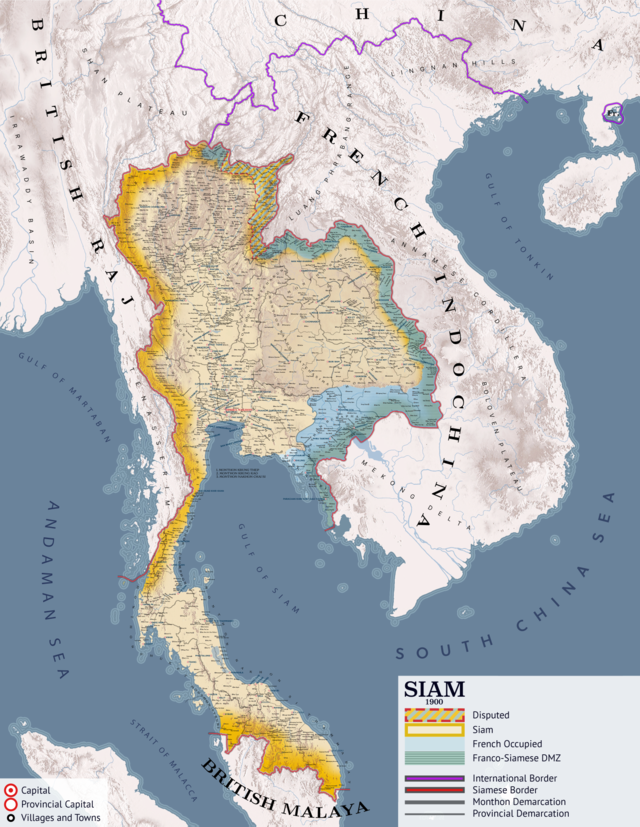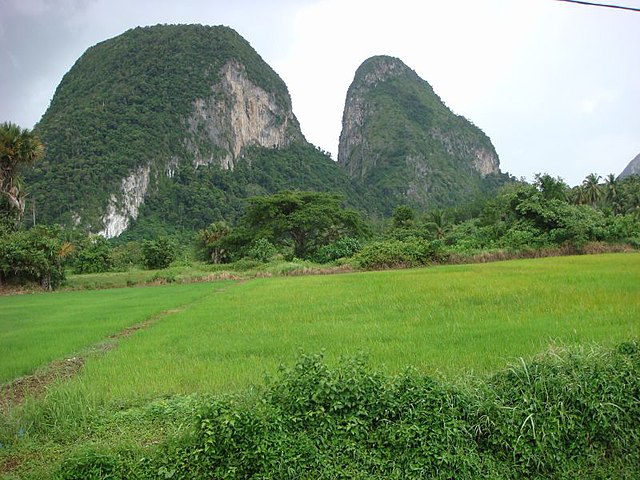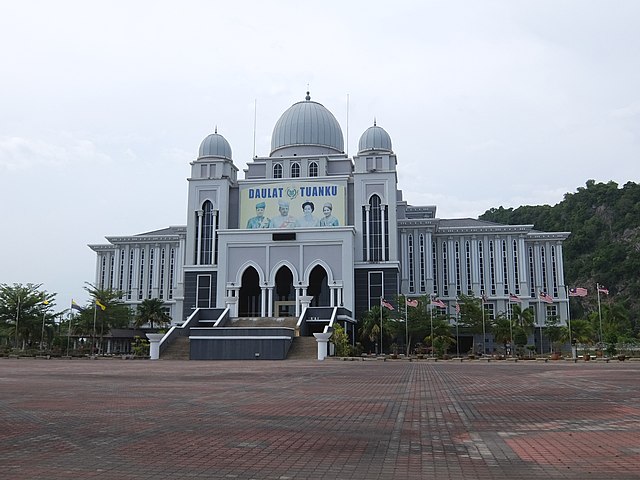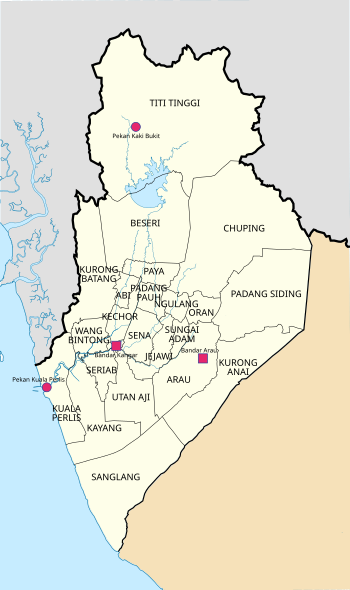Perlis
State of Malaysia From Wikipedia, the free encyclopedia
State of Malaysia From Wikipedia, the free encyclopedia
Perlis[note 1] (Kedah Malay (Perlis dialect): Peghelih), is a state of Malaysia in the northwestern coast of Peninsular Malaysia. It is the smallest state in Malaysia by area and population, as well as the northernmost in the country. The state borders the Thai provinces of Satun and Songkhla to the north and the Malaysian state of Kedah to the south. Perlis is the only Malaysian state that is not divided into districts, due to its small size, but it is still divided into several communes.[8] It was called Palit (Thai: ปะลิส) by the Siamese when it was under their influence. Perlis had a population of 227,025 as of the 2010 census.[1]
Perlis
Peghelih | |
|---|---|
| Other transcription(s) | |
| • Jawi | ڤرليس |
| • Chinese | 玻璃市 Bōlíshì (Hanyu Pinyin) |
| • Tamil | பெர்லிஸ் Perlis (Transliteration) |
| • Thai | ปะลิส Palit (RTGS) |
| Anthem: Amin, Amin, ya Rabaljalil امين امين يا رب الجليل Amen, Amen, o Majestic Lord | |
 | |
| Coordinates: 6°30′N 100°15′E | |
| Country | |
| Capital (and largest city) | Kangar |
| Royal capital | Arau |
| Government | |
| • Type | Parliamentary constitutional monarchy |
| • Raja | Sirajuddin |
| • Menteri Besar | Mohd Shukri Ramli (PN–PAS) |
| Area | |
| • Total | 819 km2 (316 sq mi) |
| Highest elevation (Mount Perlis) | 733 m (2,405 ft) |
| Population (2023)[2] | |
| • Total | 292,700 |
| • Density | 360/km2 (930/sq mi) |
| Demonym | Perlisian |
| State Index | |
| • HDI (2022) | |
| • GDP (2019) | |
| • Per capita (2019) | |
| Postal code | 01xxx to 02xxx |
| Calling code | 04 |
| ISO 3166 code | MY-09 |
| Vehicle registration | R |
| Establishment of Kota Sena as capital of Kedah | 1653 |
| Vassal state of Siam governed by Raja Long Krok | 1839[5] |
| Kingdom formed when Syed Hussain appointed as King by Siam[6] | 20 April 1843 |
| Accession into the Federation of Malaya | 1 February 1948 |
| Independence as part of the Federation of Malaya | 31 August 1957 |
| Website | www |
Perlis experiences a tropical monsoon climate. Much of the state's highlands are part of the Nakawan Range, a subrange of the Tenasserim Hills system that spans through southern Myanmar, Southern Thailand and the Peninsular Malaysia, with Mount Perlis as the highest point at 733 m. The Nakawan also forms a natural frontier between Perlis and Thailand.
The capital of Perlis is Kangar, and the royal capital is Arau. Another important town is Padang Besar, at the Malaysia–Thailand border and Kuala Perlis, the ferry town to Langkawi. The main port and ferry terminal is at the small village of Kuala Perlis, linking mostly to Langkawi Island. Another important lately developed area is Pauh Putra within the subdistrict of Kurong Anai which houses the main campus of Malaysia University of Perlis[9] and Politeknik Tuanku Syed Sirajuddin. Perlis has a snake sanctuary and research centre at Sungai Batu Pahat. Perlis State Park and Gua Kelam are among the popular tourist attractions.
The origin of the toponym 'Perlis' is vague. However, there are several theories:
The honorific "Indera Kayangan" was given by Tuanku Raja Syed Hussin Jamalullail (who ruled Perlis from 1843 to 1873) after the royal town of Indera Kayangan II (1797 until 1813) he was raised in now located in Kampung Langgar, Kayang within the Kuala Perlis area.[12] However, this epithet became less popular under the recommendation of Tuanku Syed Sirajuddin Putra Jamalullail in 2015, in which according to him is inline with the official singular name given in the state constitution his father signed without any long epithets in general "which is related to deities, or any 'Darul'..."".[7]

Perlis was originally part of Kedah, although it occasionally came under the rule of Siam or Aceh. Perlis was historically an important realm within the Kingdom of Kedah. Sultan Muhyiddin of Kedah made his capital in Kota Sena, while Sultan Dhiauddin II made Kota Indera Kayangan his capital.[14] Sultan Dhiauddin II of Kedah was honorifically titled as Raja Muda of Perlis and Kedah,[15][16] akin to the title Prince of Wales in the United Kingdom. During his reign as the Sultan of Kedah, he oversaw a treaty with George Leith to cede Province Wellesley to Penang. He was titled as Raja Muda of Perlis and Kedah.[17] This fact depicted Perlis was a special realm within the Kedah sultanate.
Sultan Dhiauddin then made Syed Harun Jamalullail, father of the future first Raja of Perlis as chieftain of Arau as a wedding gift to his marriage with his daughter, Tengku Sofiah. Syed Harun's descendant eventually become deputy governor (1839) and Raja of Perlis.[18]
After the Siamese conquered Kedah in 1821, the British felt their interests in Perak were threatened.[19] This resulted in the 1826 Burney and Low Treaties[20] formalising relations between the two Malay states and Siam, their nominal overlord. In the Burney Treaty, the exiled Sultan of Kedah, Ahmad Tajuddin was not restored to his throne. Sultan Ahmad and his armed supporters then fought in a series of war known as Perang Musuh Bisik for his restoration from 1830 to 1842.[21] Towards the end of the conflict and the death of Siam's Ligor governor in 1839 (Siam's main authority figure over Kedah), Perlis was separated with Kedah.[19]
In 1842, the Sultan agreed to accept Siamese terms and was restored to the throne of Kedah. However, Siam separated Perlis into a separate principality which was a direct vassal of Bangkok. The Siamese made Raja Long Krok as the Governor of Siam in Perlis while Syed (or Sayyid) Hussain Jamalullail as deputy governor. On 20 May 1843, the Siamese made Sayyid Hussain Jamalulail, the paternal grandson of a Hadhrami Arab Sayyid immigrant and maternal grandson of the Sultan of Kedah, the first Raja of Perlis[22] which made Perlis a sovereign state. His descendants still rule Perlis, but as rajas, instead of as sultans.
In 1897, Kedah led by its prime minister, Wan Mat Saman began efforts to end the sovereignty of Perlis (similar to the Kingdom of Kubang Pasu which was absorbed into Kedah). After several tense occasions and disputes, the Siamese king Chulalongkorn sided with Perlis.[23] Perlis also had several disputes with the state of Setul before the 1900s.
As with Kedah, the Anglo-Siamese Treaty of 1909 forced Siam to relinquish its southern Malay vassal states of Kelantan, Trengganu, and Monthon Syburi (comprising Kedah, Perlis, and Satun (but Satun remained with Thailand)) to Great Britain. The British installed a Resident in the Perlis royal capital of Arau. Perlis was returned to Siam in World War II as a reward for Siam's alliance with Japan, but this brief annexation ended with the Japanese surrender. After World War II, Perlis returned to British rule until it became part of the Malayan Union, then the Federation of Malaya in 1957, and lastly, Malaysia in 1963.
Since 2000, the raja has been Sirajuddin. He was the Yang di-Pertuan Agong (King of Malaysia) from 13 December 2001 to 12 December 2006.[24] Tuanku Syed Faizuddin Putra was the Regent of Perlis during the five-year period when Tuanku Syed Sirajuddin was Yang di-Pertuan Agong. The Chief Executive or Menteri Besar is currently Mohd Shukri Ramli of the Perikatan Nasional.

Perlis is the smallest state in Malaysia, covering a total land area of 819 km2. Like other west coast states, it has a coastline facing the Strait of Malacca, measuring around 20.4 km (12.7 mi) from Kuala Sanglang at the border with Kedah's Kubang Pasu District up north towards the Malaysia-Thailand border near Pos Batu Putih, in the vicinity of Kuala Perlis.
From south to north, its topographical profile consists of flat, arable lands of the Kedah–Perlis Plain dotted with numerous mogotes, and abruptly rises up high as rolling karstic hills of the Nakawan Range, which forms the natural boundary between the state and the province of Satun on the Thai side. In general, paddy fields dominate much of the state's landscape as the Perlisian portion of the Kedah–Perlis Plain had been utilized for rice farming since antiquity. Meanwhile, the Nakawan runs southwest–northeast along the Thai border from Kuala Perlis towards Kaki Bukit. The range is home to the 733-metre tall Mount Perlis, the highest point in the state.
Along with northern Kedah, the entirety of Perlis experiences tropical monsoon climate (Köppen climate classification: Am).
| Climate data for Kangar | |||||||||||||
|---|---|---|---|---|---|---|---|---|---|---|---|---|---|
| Month | Jan | Feb | Mar | Apr | May | Jun | Jul | Aug | Sep | Oct | Nov | Dec | Year |
| Mean daily maximum °C (°F) | 30.2 (86.4) |
32.4 (90.3) |
32.4 (90.3) |
31.1 (88.0) |
30.2 (86.4) |
29.9 (85.8) |
29.5 (85.1) |
29.4 (84.9) |
29.1 (84.4) |
28.9 (84.0) |
28.9 (84.0) |
28.9 (84.0) |
30.1 (86.1) |
| Daily mean °C (°F) | 26.4 (79.5) |
27.7 (81.9) |
28 (82) |
27.6 (81.7) |
27.4 (81.3) |
27.4 (81.3) |
27 (81) |
26.9 (80.4) |
26.5 (79.7) |
26.1 (79.0) |
26 (79) |
25.9 (78.6) |
26.9 (80.5) |
| Mean daily minimum °C (°F) | 23.7 (74.7) |
24.1 (75.4) |
24.8 (76.6) |
25.2 (77.4) |
25.4 (77.7) |
25.3 (77.5) |
25 (77) |
24.8 (76.6) |
24.6 (76.3) |
24.4 (75.9) |
24.3 (75.7) |
24 (75) |
24.6 (76.3) |
| Average precipitation mm (inches) | 48 (1.9) |
44 (1.7) |
121 (4.8) |
171 (6.7) |
205 (8.1) |
161 (6.3) |
167 (6.6) |
196 (7.7) |
220 (8.7) |
272 (10.7) |
218 (8.6) |
129 (5.1) |
1,952 (76.9) |
| Source: Climate-Data.org[25] | |||||||||||||


Perlis is ruled by the House of Jamalullail. Unlike most other Malay states, in which the ruler is a "sultan", the ruler of Perlis is called the "raja".[26]
Legislative power in the state is exercised by the Perlis State Legislative Assembly, a unicameral chamber in which all 15 seats are elected from single-member constituencies. After the 2022 state election, the Perikatan Nasional coalition, led by the Malaysian Islamic Party, holds 14 of the assembly's 15 seats.
The raja appoints menteri besar (chief minister) and an Executive Council (akin to a Cabinet). Generally, the chief minister is a member of the legislative assembly who can command a majority on the assembly's floor. The raja's appointment powers were at the centre of a brief constitutional crisis in the state after the 2008 general election. The Raja sought to appoint a Barisan Nasional assemblyman, Md Isa Sabu, as chief minister despite Prime Minister Abdullah Badawi, who led the national coalition, nominating the incumbent Shahidan Kassim to continue in office. The Raja prevailed, and swore in Md Isa, who proceeded to serve a full term as chief minister.[27]
The state elects three members of the federal House of Representatives, for the constituencies of Arau, Kangar and Padang Besar. All three seats have been held by the Perikatan Nasional since the 2022 general elections.
The state also has two federal senators; like all other states, the senators are not directly elected but appointed by a vote of the state legislative assembly.
Perlis, being the smallest state by area in Malaysia, is not divided into administrative districts. It is, however, still divided into 22 mukims (communes), namely:

 | |||||
| Affiliation | Coalition/Party Leader | Status | Seats | ||
|---|---|---|---|---|---|
| 2022 election | Current | ||||
| Perikatan Nasional | Mohd Shukri Ramli | Government | 14 | 14 | |
| Pakatan Harapan | Gan Ay Ling | Opposition | 1 | 1 | |
| Total | 15 | 15 | |||
| Government majority | 9 | 9 | |||
| Year | Pop. | ±% | ||
|---|---|---|---|---|
| 1970 | 121,062 | — | ||
| 1980 | 144,782 | +19.6% | ||
| 1991 | 183,824 | +27.0% | ||
| 2000 | 198,288 | +7.9% | ||
| 2010 | 225,630 | +13.8% | ||
| 2020 | 284,885 | +26.3% | ||
| ||||
| Source: [28] | ||||

| Religion in Perlis – 2010 Census[29] | ||||
|---|---|---|---|---|
| religion | percent | |||
| Islam | 87.9% | |||
| Buddhism | 10.0% | |||
| Hinduism | 0.8% | |||
| Christianity | 0.6% | |||
| Others | 0.3% | |||
| Chinese Ethnic Religion | 0.2% | |||
| No Religion | 0.2% | |||
As of 2010 the population of Perlis is 87.9% Muslim, 10.0% Buddhist, 0.8% Hindu, 0.6% Christian, 0.2% Taoist or Chinese religion followers, 0.2% non-religious, 0.2% unknown / none, and 0.1% followers of other religions.
The Malaysian defines "Malay", as those who are Muslim, speak Malay regularly, practise Malay customs, and lived in or have ancestors from Brunei, Malaysia and/or Singapore.[30] Statistics from the 2010 Census indicate that 83.6% of the Chinese population identify as Buddhist, with significant numbers of adherents following Christianity (11.1%) and Taoism (3.4%), along with small Hui-Muslim populations in areas like Penang. The majority of the Indian population follow Hinduism (86.2%), with a significant minority identifying as Christians (6.0%) or Muslims (4.1%). Christianity is the predominant religion of the non-Malay bumiputera community (46.5%) with an additional 40.4% identifying as Muslims.[31]
Majority of Perlis' population speaks Perlis Malay which is a sub-dialect of Kedah Malay but has its own unique features compared to those of neighbouring Kedah. Perlisian Chinese people are mostly Hokkien by ancestry and speak a dialect of Hokkien. Besides that there is also Hokkien, Mandarin, English, Tamil, Malayalam as well as small numbers of Southern Thai speakers, mostly ethnic Malaysian Siamese. However, large numbers of Perlisians regardless of ethnic origin mainly uses Perlis Malay as a lingua franca. In particular, Perlis is well known for its distinctive Hokkien language, known as Penang Hokkien. Hokkien serves as the lingua franca among the various ethnic Chinese communities in Perlis. Perlis Chinese are predominantly Hokkien and thus mostly speak Hokkien as their first language.
Some of the tourist attractions in Perlis are:

The KTM West Coast railway line runs through Perlis with stations at Padang Besar and Arau. KTM ETS (towards KL Sentral) and KTM Komuter Northern Sector (towards Butterworth) trains regularly call at both stations.
Perlis does not have an airport; Sultan Abdul Halim Airport serving Alor Setar in nearby Kedah is the nearest airport within Malaysia and can be reached by one hour's drive from Kangar. A bus service from Arau to the airport is also available.
There is an outdoor rock climbing area in the limestone hills of Bukit Keteri with over 50 sport climbing routes that are bolted by the world's climbing team; the crags are split into two, both next to each other and the rockfaces rise to 350 m. The range of difficulty is from beginner to expert and many varieties of climbs are available.
Seamless Wikipedia browsing. On steroids.
Every time you click a link to Wikipedia, Wiktionary or Wikiquote in your browser's search results, it will show the modern Wikiwand interface.
Wikiwand extension is a five stars, simple, with minimum permission required to keep your browsing private, safe and transparent.